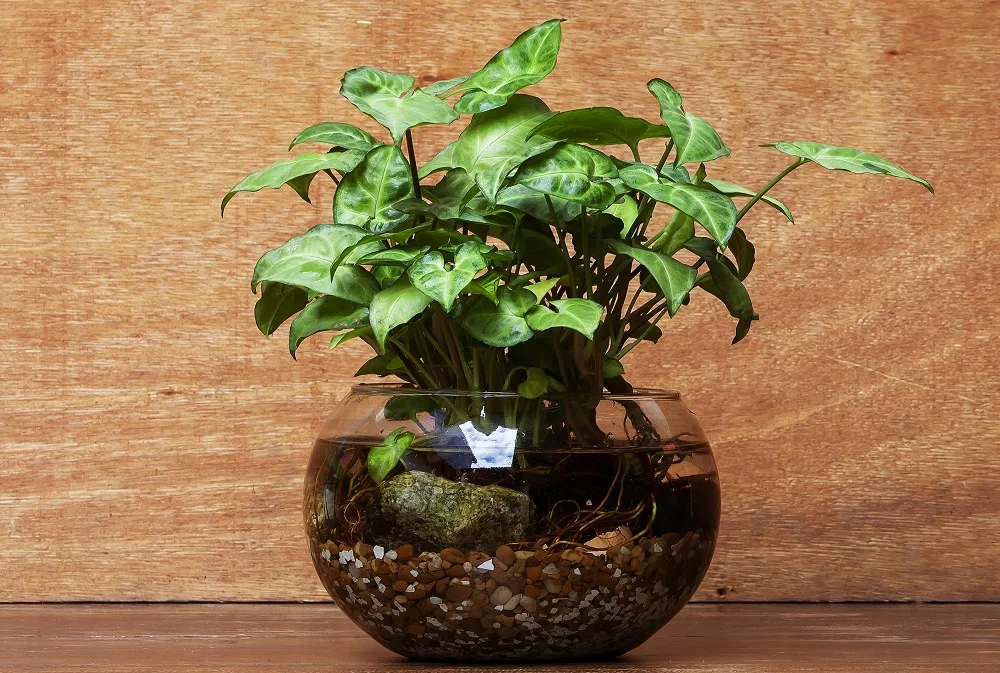Ever find yourself captivated by the lush, arrow-shaped leaves of a Syngonium plant, also known as the Arrowhead plant? It’s one of those houseplants that instantly brightens up a room with its vibrant green foliage. If you’ve got a Syngonium at home, you’re in luck because propagating this plant is both easy and satisfying! Whether you’re looking to expand your plant collection or just want to try something new, this guide to Syngonium propagation in water will help you get started with just a few steps. Let’s dive in!
Gather Your Materials
To start, gather these essentials for successful Syngonium Propagation in Water:
- Healthy Syngonium Plant: Choose a mature, healthy plant for the best cuttings.
- Sharp, Clean Pruning Shears: These are a must for cutting stems without damaging them.
- Glass Jar or Clear Vase: Seeing the roots grow through glass makes the process even more exciting!
- Filtered or Distilled Water: Your Syngonium cuttings will thrive better in clean, fresh water.
- Optional: A rooting hormone can speed up the process, but it’s not necessary (as you can check in the video above, this is not necessary in my experience).
Now that we’ve got everything ready, let’s go ahead with cutting and placing our Syngonium cuttings in water.
How to Propagate Syngonium Cutting in Water
1. Select Your Cutting:
Pick a healthy Syngonium vine with a few leaves and at least one node (this is the small bump along the stem where roots will sprout). Choose a piece with a decent length to make sure it has room to grow.
2. Make the Cut:
With your pruning shears, cut below the node, leaving enough room for the cutting to stand tall in water. Removing any lower leaves that could touch the water keeps the cutting from rotting, allowing the node to grow roots freely.
3. Place in Water:
Put your Syngonium cutting into a glass jar filled with fresh water. Make sure the node is submerged, as this is where roots will sprout. Place your jar in a spot with indirect light—Syngoniums like bright, but not harsh sunlight.
4. Wait and Watch:
Now comes the fun part—watching roots emerge! Over the first few days, you might notice small white roots beginning to form at the node. Keep the water clean by changing it every 3-5 days, and enjoy watching your plant baby grow!
5. Planting (Optional):
Once the roots reach 1-2 inches, you can either transfer your Syngonium to soil or keep it as a water plant. If you choose to plant it, go with a potting mix that drains well to prevent waterlogging.
How to Care for Syngonium
Syngoniums are pretty low-maintenance, but a few tips will keep them growing happily:
- Light: Place in bright, indirect sunlight. Avoid direct sunlight as it can burn the leaves.
- Water: Water regularly, but allow the top inch of soil to dry out between waterings. Over-watering can lead to root rot.
- Humidity: Like most tropical plants, Syngoniums love humidity! Mist your plant or use a humidifier if the air is particularly dry.
- Soil: A well-draining, peat-based potting mix is ideal. This type of soil helps retain moisture without letting it sit too long.
- Fertilizer: Feed with a balanced liquid fertilizer during spring and summer every 4-6 weeks. Syngoniums don’t need much food, so only fertilize during the growing season.
- Pruning: Regular trimming will encourage a fuller shape, and you can use these cuttings to propagate even more plants!
Conclusion
And there you have it—an easy way to try Syngonium propagation in water and grow your own indoor jungle! Propagating these lovely Arrowhead plants not only gives you more beautiful greenery but also allows you to share the joy of growing with friends and family. Plus, watching roots sprout and new leaves unfurl is incredibly satisfying. So, grab those shears, take a cutting, and start your Syngonium propagation journey today!
Whether you’re propagating just for fun or looking to add a pop of green to every room, Syngoniums are perfect plants for everyone—from beginners to plant experts. Let me know how your propagation journey goes, and feel free to share tips or questions in the comments below. 🌿
Happy propagating!
Want to learn more check out these related articles:
Give it a try and let me know how it works for you! And don’t forget to subscribe to TheHomePlants YouTube channel for more easy, plant-saving DIY tips and tricks.

